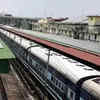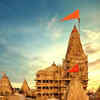 It’s a sight so common, most of us have stopped noticing it.
It’s a sight so common, most of us have stopped noticing it.
Step outside almost any major railway station in India—from Delhi to Dhanbad, Chennai to Chhattisgarh—and you’ll likely find a modest shrine dedicated to Lord Hanuman nearby. Sometimes it’s a small idol under a tree, sometimes a brick-red temple with a trident atop. It may not even have a priest, but there will be incense, sindoor, and offerings—proof of daily visitors.
But why Hanuman?
And why so often near railway stations?
This recurring presence isn’t just a matter of coincidence or religious randomness. It stems from a mix of historical patterns, cultural psychology, and grassroots faith practices that go back over a century.
In this piece, we look at how Hanuman came to stand watch over India’s most chaotic, human places of transit, and what his presence reveals about our relationship with travel, uncertainty, and devotion.
1.
Hanuman: The Eternal Traveller’s Guardian

In the
Ramayana, Hanuman is not just a warrior or devotee—he is a messenger, a mover, a protector who crosses lands and seas to serve his purpose. His journeys are many—leaping across oceans to find Sita, flying over mountains to bring the Sanjeevani herb, and traversing forests to carry Lord Rama’s words. His movement is never aimless. It is purposeful, selfless, and often carried out in the face of danger.
This quality—movement with devotion and strength—is perhaps why Hanuman is seen as a natural guardian for travellers. Especially in a country where journeys often begin not with the purchase of a ticket, but with a folded hand at a temple.
For those boarding a train—an act that even today carries its own share of uncertainty and distance—invoking Hanuman is to seek strength and safety. He is, after all,
Sankat Mochan—the one who removes dangers.
2. A Shrine Born of Workers’ Faith

The Indian Railways, established in the mid-19th century under British rule, was built not just with steel and steam, but with the labour of thousands—many of whom came from deeply religious backgrounds.
As rail lines expanded across provinces, workers and coolies often installed Hanuman idols at worksites, praying for strength during grueling hours and for protection from accidents. Over time, these idols remained even after the work ended. Shrines were built around them. As stations grew, so did the presence of these sacred spaces.
In many older towns, locals still recall stories of how the first temple came up—not as an organised structure, but as a gesture of faith from the hands of those who built the tracks.
3. Hanuman and the Working Class

Unlike deities enshrined in palaces or grand mandirs, Hanuman has always belonged to the working people—porters, labourers, drivers, guards. He requires no elaborate rituals. A simple offering of sindoor, a few petals, and a heartfelt prayer is enough.
At any station in Uttar Pradesh or Bihar, you’ll see coolies bowing their heads before the shrine before lifting the first load of the day. Hawkers glance at him between sales. Travellers stop briefly, some whispering a prayer, others simply meeting his gaze before boarding their trains.
To them, he is not distant. He is present. Watching. Guarding.
4. A Stillness in the Midst of Movement

Railway stations are not calm places. They are noisy, hurried, and filled with people moving towards destinations unknown. In this commotion, a Hanuman shrine offers stillness. Even if it’s just for a moment.
There is something deeply Indian about this contrast—a divine space quietly placed beside the machinery of modern life. No fanfare. Just faith. People ring the bell, light a diya, touch the wall of the shrine before boarding. No one tells them to. It is simply known.
5. Temples That Outlast Timetables Some of these shrines have grown into larger temples over time. The Hanuman Mandir outside Patna Junction is one of the most well-known. For many, visiting the temple is part of the journey itself—you take darshan before entering the station.
In other places, the shrine remains small, unmarked on maps, yet deeply alive in the memory of those who pass by it regularly. These are not just temples—they are custodians of community memory, silently witnessing the comings and goings of generations.
6. Why Only Hanuman?

One may ask, why not a temple to Krishna, or Shiva, or Durga?
Because Hanuman represents the one who walks with you. He carries mountains, leaps over fear, protects without pride. Unlike deities of wealth, wisdom, or creation, Hanuman’s power lies in service. He does not sit in judgment. He acts.
And so, at the threshold of a journey—particularly one by train, with its known unpredictability—Hanuman is the one people turn to. Not for grandeur, but for the quiet assurance of safety.
A Presence That Needs No Announcement The next time you walk into a railway station and see a small Hanuman idol—under a tree, beside a gate, or near the platform—pause for a moment. Notice the flickering flame, the faded garlands, the smudges of sindoor.
This is not coincidence. It is culture. It is memory. It is the deep, unspoken Indian way of placing the sacred beside the everyday.
Where there is movement, there is hope. And where there is hope, Hanuman stands—silent, strong, and watching over us all.
 It’s a sight so common, most of us have stopped noticing it.
It’s a sight so common, most of us have stopped noticing it.
 In the
Ramayana, Hanuman is not just a warrior or devotee—he is a messenger, a mover, a protector who crosses lands and seas to serve his purpose. His journeys are many—leaping across oceans to find Sita, flying over mountains to bring the Sanjeevani herb, and traversing forests to carry Lord Rama’s words. His movement is never aimless. It is purposeful, selfless, and often carried out in the face of danger.
In the
Ramayana, Hanuman is not just a warrior or devotee—he is a messenger, a mover, a protector who crosses lands and seas to serve his purpose. His journeys are many—leaping across oceans to find Sita, flying over mountains to bring the Sanjeevani herb, and traversing forests to carry Lord Rama’s words. His movement is never aimless. It is purposeful, selfless, and often carried out in the face of danger.
 The Indian Railways, established in the mid-19th century under British rule, was built not just with steel and steam, but with the labour of thousands—many of whom came from deeply religious backgrounds.
The Indian Railways, established in the mid-19th century under British rule, was built not just with steel and steam, but with the labour of thousands—many of whom came from deeply religious backgrounds.
 Unlike deities enshrined in palaces or grand mandirs, Hanuman has always belonged to the working people—porters, labourers, drivers, guards. He requires no elaborate rituals. A simple offering of sindoor, a few petals, and a heartfelt prayer is enough.
Unlike deities enshrined in palaces or grand mandirs, Hanuman has always belonged to the working people—porters, labourers, drivers, guards. He requires no elaborate rituals. A simple offering of sindoor, a few petals, and a heartfelt prayer is enough.
 Railway stations are not calm places. They are noisy, hurried, and filled with people moving towards destinations unknown. In this commotion, a Hanuman shrine offers stillness. Even if it’s just for a moment.
Railway stations are not calm places. They are noisy, hurried, and filled with people moving towards destinations unknown. In this commotion, a Hanuman shrine offers stillness. Even if it’s just for a moment.
 One may ask, why not a temple to Krishna, or Shiva, or Durga?
One may ask, why not a temple to Krishna, or Shiva, or Durga?